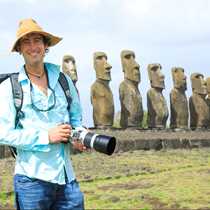The beauty of travel photography is more than creating nice pictures, it is telling a story. The Galápagos Islands are rich with both photogenic fauna, and a fascinating story ready to be told. There is the story of good news, a place which has been set aside to be protected by conservation, thanks to the money that is generated through ecotourism. Furthermore, it is a story of evolution, as the plants and animals of each island tell their unique piece of the puzzle, which we can clearly understand. Today the National Geographic Endeavour is visiting the Charles Darwin Research Station to learn about both of these subjects – conservation and evolution.
One individual animal has saved his species, the mighty “Super Diego.” On Española Island, due to previous human habits, only 14 giant tortoises remained of their entire species. 12 females and two males shared the island, but were isolated on opposite ends. They were rescued and brought to the Charles Darwin Research Station to begin the era of breeding and repatriation, but the tortoises would not mate. A call was put out to the international community in search for a male from Española, and the call was answered by the San Diego Zoo. They were eager to help with the conservation effort, and the tortoise was flown back to Galápagos and named Diego to honor his old home. Diego arrived, and with surfboard in hand and wearing Ray-Ban sunglasses, he said, “Hello ladies.” Thanks to Diego, and the other hard working tortoises, more than 2,000 juveniles have been repatriated back to Española Island. That is a good news story of conservation. Furthermore, this and many other success stories have been possible thanks to the generous donations from the travelers of Lindblad Expeditions-National Geographic.
Our photographs today also share the story of evolution. Diego and the survivors of Española Island have a distinctly shaped shell thanks to the climatic conditions of the island. Española is small, flat, and dry, so the tortoises must reach for their food. For this reason alone, their shell is arched up in the front like a saddle to allow their long necks to reach high above the ground.
In the afternoon, we visit the lush highlands of Santa Cruz. We find many giant tortoises, and they are extremely different from Diego and the tortoises of Española. Here the large island receives a great amount of rain throughout the year, and we walk among the thick vegetation. The rain brings grass, so the tortoises here don’t have to reach up for their food. Instead they are shaped like little tanks, and their shell reaches down in front to help them move through the dense forest.
These tortoises share a common ancestor, and they are one of the best examples of evolution by the process of natural selection. Whichever story our photos tell, conservation, evolution, or both, one can also be amazed simply by the tortoise’s splendor. Reaching up to 450 lbs, these hefty herbivores are beautiful. The tortoises show little fear while we approach and take great photos.
In town we also have time to see a bit of local life. The fish market is always an interesting place to find a symbiotic relationship among the fishermen’s wives and the animals they feed. Galápagos sea lions and brown pelicans both share in the spoils, and permit very close encounters for our guests. The sea lions beg like dogs, and are rewarded with scraps of fish. It is a fury of fur and feathers as they compete for tasty morsels. Our guests laugh while shooting pictures of the bizarre interactions. It has been another wonderful day aboard the National Geographic Endeavour.




